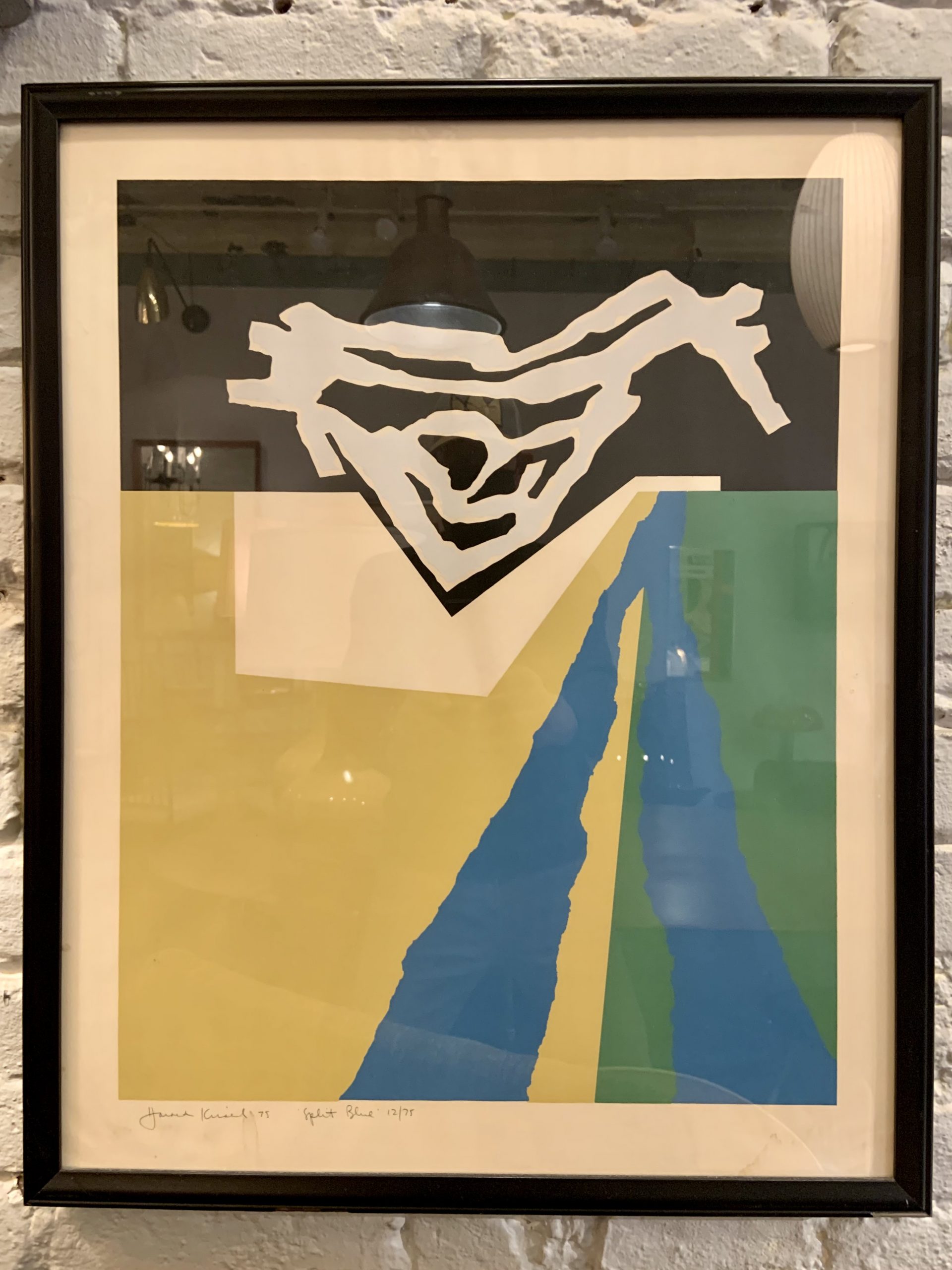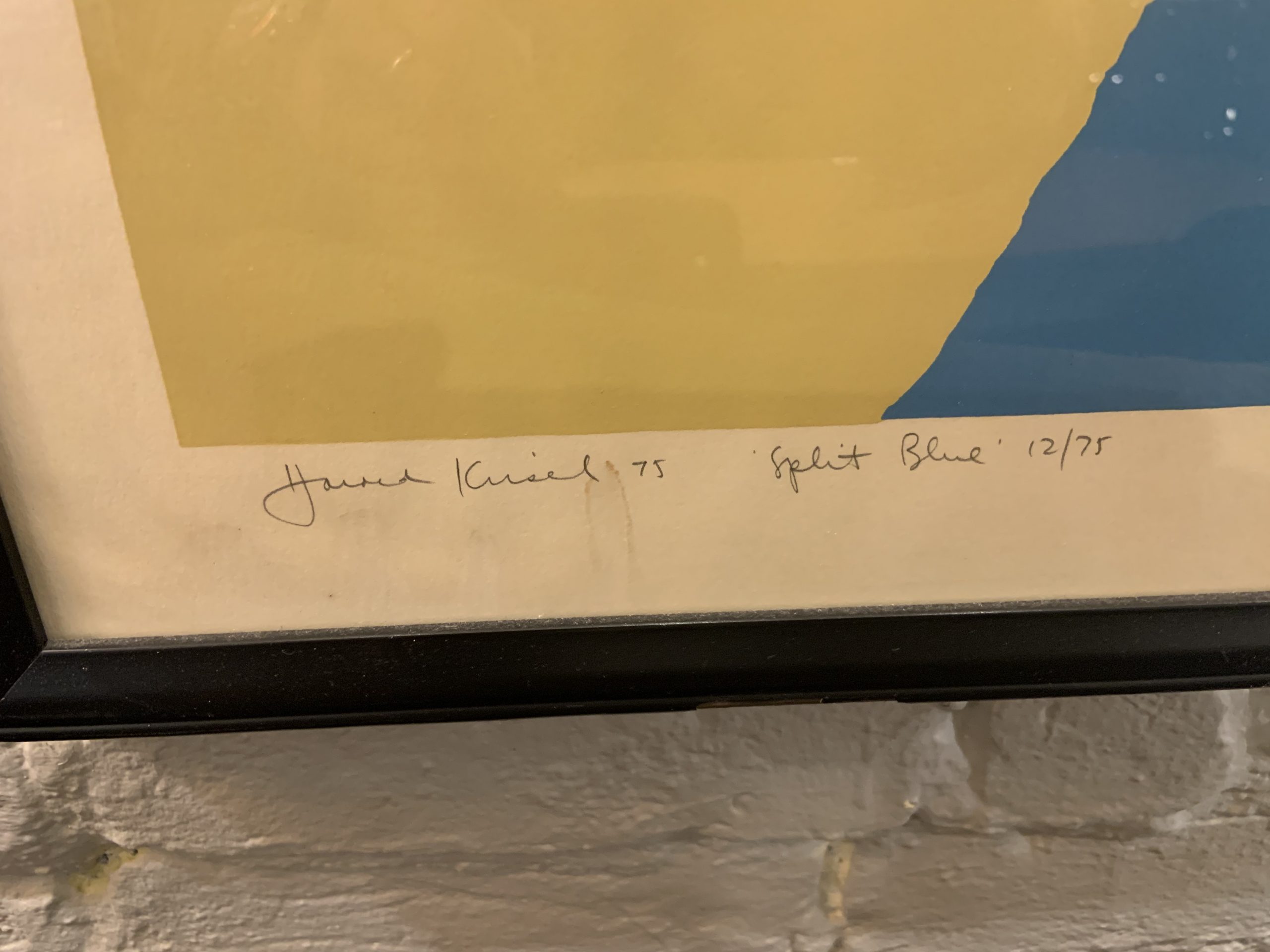Framed Silk Screen by Harold Krisel titled Split Blue and made in 1975. Signed, titled, dated and numbered 12/75. In very good condition with light water stains along the bottom border. Measures 20 X 25.
Harold Krisel
1920 – 1995

Harold Krisel was born in 1920 in Brooklyn, NY. His passion for creating art began at an early age, when as a child, he used brown paper grocery bags as his canvas. In the 1930’s, as a teenager he received a scholarship to The American Artist School in NYC with Carl Holty and Harry Holtzman. It was Holtzman who brought Mondrian to the states to escape the Blitzkrieg in London. Krisel’s meeting with Mondrian was a key influence on his entry into the world of abstract art.
When the U. S. entered the war, Krisel was drafted into the Army Air Force and served from 1942-1946 drawing weather maps. He was stationed state side and lived off base with his new young wife, Rose Breuer. He produced sculptures, charcoal and ink drawings during the war. Afterwards, he studied architecture in Chicago at the New Bauhaus from 1946-1949 on the G. I. Bill. He became a member of the American Abstract Artists when he was twenty-six and retained this membership for the duration of his life.
Rose and Harold had three daughters. Judith and Elisabeth were born in Chicago in 1950, and 1952, respectively. Harold completed his graduate studies at the Illinois Institute of Technology in 1952, and the couple headed east, stopping in Cambridge, MA for a one-semester appointment teaching design at MIT, and then on to NYC, where his third daughter, Martha, was born in 1955. Harold worked as an architect at Skidmore, Owings and Merrill from 1953 to 1966. He was featured on the February cover of Interiors Magazine in 1955 and the April cover of Architectural Forum in 1964.
The Krisel family became avid travelers, spending several summers traversing France and Italy. Never truly a corporate man, Harold traded in his career as an architect at a big firm to become a teacher at the High School of Art and Design in NYC, teaching architecture; a lifestyle that afforded him time for his family, artwork, and inspirational travel. Summers were spent traveling or producing editions of silkscreens on the back porch of a summer rental, transformed into a studio, on Cape Cod. Silkscreen production became a family affair, with Rose as the inspector. Krisel hand cut the stencils for each color he silk-screened, registered them and hand-printed editions of up to sixty or more copies. One or two colors had to be produced each day, before the family could relax at the beach.
In 1955 he met his primary patron, Roger Milliken. Today Milliken is one of the largest textile manufacturers in the world. Among their projects, Harold was commissioned to design a 26,000 square foot aeration pond for Milliken’s headquarters. To live in the Krisel apartment in Long Island City was to live immersed in a studio; every surface covered by the artistic materials miniature models, collages, drawings, and flat files filled with editions of prints on heavy Strathmore paper.
Harold and Rose retired to the village of Bridgehampton, NY in 1981, where he pursued his lifelong dream of dedicating himself full time to his artwork. Here he worked on commissioned sculptures and large murals, as well as a series of prints. The Krisel residence in Bridgehampton was as much studio as it was home. Harold designed a square, symmetrical home featuring an unobstructed 360-degree view of former potato fields, then overgrown and inhabited by pheasants, when the Hamptons were still quiet and peaceful. The studio was full of solvents, tables, drying racks, wood working equipment and a dark room. Facing west was a sunken sculpture garden. Harold and his family built all of the furniture for the house in his studio.
Harold was extremely prolific, working in wood, gauze, wax, paper, and collage, interrupted only by a knock on the second floor window by Rose to remind him that it was time to for a meal. These were very happy years for Harold, where he would be seen covered by paint or sawdust, working in his studio. Every afternoon Harold, Rose, and their visiting children and grandchildren could be seen walking on the beach. He lived in Bridgehampton surrounded by his family and his art, both the loves of his life, until 1995 when he died of Alzheimer’s disease.
Over his lifetime, he produced a prodigious quantity of artwork, including hundreds of silkscreens, freestanding bronze sculptures, and wooden relief sculptures, oil paintings, ink drawings, acrylic paintings, and commissioned murals, architectural fountains and memorials. His work continues to bring happiness to all who hang it on their walls.
Represented in the following collections: The Metropolitan Museum of Art, Museum of Modern Art, Whitney Museum of American Art, The Guggenheim Museum, Smithsonian American Art Museum, Houston Museum of Art, British Museum in London, Bibliotheque National in Paris, Philadelphia Museum of Art, Library of Congress in Washington, DC, Princeton and Yale Universities, Smith College Museum of Art, and the Carnegie Institute.
SOLD.


